
Caravaggio Painting Reproductions 1 of 4
1571-1610
Italian Baroque Painter
Michelangelo Merisi da Caravaggio (29 September 1571 – 18 July 1610) was an Italian artist active in Rome, Naples, Malta and Sicily between 1593 and 1610. He is commonly placed in the Baroque school, on which he had a formative influence.
Early life (1571-1592)
Caravaggio’s father Fermo Merisi was a household administrator and architect-decorator to Francesco Sforza, Marchese of Caravaggio, a town some thirty kilometers from Milan. His mother, Lucia Aratori, came from a propertied family of the same district. None of the Merisi children - Michelangelo was Lucia's eldest - are listed on the baptismal records from Caravaggio, and all were probably born in Milan, where the Marchese had his court and where their father lived.
In 1576 the family moved to Caravaggio to escape a plague which ravaged Milan. Caravaggio’s father died there in 1577. It is assumed, but not certain, that he grew up in Caravaggio; it is equally possible that some of his childhood may have passed in Milan, where it appears his family kept up connections with the Sforzas and with the powerful Colonna family, who were allied by marriage with the Sforzas and destined to play a major role in Caravaggio's later life.
In 1584, aged 13, he was apprenticed for four years to the painter Simone Peterzano of Milan, described in the contract of apprenticeship as a pupil of Titian. Caravaggio appears to have stayed in the Milan Caravaggio area after his apprenticeship ended, but it is possible that he visited Venice and saw the works of Giorgione, whom he was later accused of aping, as well as those of his teacher’s master, Titian. Certainly he would have become familiar with the art treasures of Milan, including Leonardo’s Last Supper, and with the regional Lombard art, “modest and unflashy ... down to earth ... unrhetorical,” closer to the naturalism of Germany than to the formality and grandeur of the Roman style.
Rome (1592-1600)
In mid-1592 he arrived in Rome, “naked and extremely needy ... without provision ... short of money.” A few months later he was doing hack-work for the highly successful Giuseppe Cesari, Cavaliere d’Arpino, Pope Clement VIII’s favourite painter, “painting flowers and fruit” in the cavaliere’s factory-like workshop. Known works from this period include a small Boy Peeling a Fruit (his earliest known painting), a Boy with a Basket of Fruit, and the Young Sick Bacchus, a self-portrait done during convalescence from a serious illness that ended his employment with d’Arpino. All three demonstrate the physical particularity - one aspect of his realism - for which Caravaggio was to become renowned: the fruit-basket-boy’s produce has been analysed by a professor of horticulture, who was able to identify individual cultivars right down to "... a large fig leaf with a prominent fungal scorch lesion resembling anthracnose (Glomerella cingulata)". Allied with this type of realism is another, the psychological: the boy is clearly a little bored posing with the heavy basket, but amused and compliant; his bared shoulder is treated with such physical desire that it is quite clear how the painter felt about his model; but the boy himself, while amiable, gives no sign of reciprocating the feeling.
Caravaggio left d’Arpino in January 1594, determined to make his own way. He took with him the model for the boy with the fruit basket, a sixteen year old painter named Mario Minniti who would continue to appear in his works over many years, and began painting scenes of Roman street life which he sold through the dealer Costantino. The Fortune Teller, his first composition with more than one figure, shows Mario being cheated by a gypsy girl. The theme was quite new, and would prove immensely influential over the next century and beyond. This, however, was in the future: at the time, Caravaggio sold it for practically nothing. The Cardsharps - showing another unsophisticated boy falling the victim of card cheats - is even more psychologically complex, and perhaps Caravaggio’s first true masterpiece. Like the Fortune Teller it was immensely popular, and over fifty copies survive. More importantly, it attracted the patronage of Cardinal Francesco Maria Del Monte, one of the leading connoisseurs in Rome, and henceforth Caravaggio would share an apartment with Mario in the cardinal’s Palazzo Madama.
For Del Monte and his wealthy art-loving circle Caravaggio executed a number of intimate chamber-pieces - The Musicians, The Lute Player, a tipsy Bacchus, an allegorical but realistic Boy Bitten by a Lizard - featuring Mario and yet more boy models. These poetic, introverted, cryptically homoerotic works were a step away from the psychological realism that had begun to emerge a few years earlier. But the realism returned with Caravaggio’s first paintings on religious themes, and the emergence of a remarkable spirituality. The first of these was the Penitent Magdalene, showing Mary Magdalene at the moment when she has turned from her life as a courtesan and sits weeping on the floor, her jewels scattered around her. “It seemed not a religious painting at all ... a girl sitting on a sitting on a low wooden stool drying her hair ... Where was the repentance ... suffering ... promise of salvation?” It was understated, in the Lombard manner, not histrionic in the Roman manner of the time. It was followed by others in the same style: Saint Catherine, Mary and Martha, Judith and Holofernes, a Sacrifice of Isaac, a Saint Francis of Assisi in Ecstasy, and a Rest on the Flight into Egypt. The works, while viewed by a comparatively limited circle, increased Caravaggio's fame with both connoisseurs and his fellow-artists. But a true reputation would depend on public commissions, and for these it was necessary to look to the Church.
'Most Famous Painter in Rome' (1600-1606)
In 1599, presumably through the influence of Del Monte, Caravaggio was contracted to decorate the Contarelli Chapel in the Church of San Luigi dei Francesci. The two works making up the commission, the Martyrdom of Saint Matthew and Calling of Saint Matthew, delivered in 1600, were an immediate sensation. Caravaggio’s heightened chiaroscuro brought high drama to his subjects, while his acutely observed realism brought a new level of emotional intensity. This heightened form of chiaroscuro is known as tenebrism and he is credited with popularizing it. Opinion among Caravaggio’s artist peers was polarised. Some denounced him for various perceived failings, notably his insistence on painting from life, without drawings, but for the most part he was hailed as the saviour of art: "The painters then in Rome were greatly taken by this novelty, and the young ones particularly gathered around him, praised him as the unique imitator of nature, and looked on his work as miracles.”
Caravaggio went on to secure a string of prestigious church commissions featuring violent struggles, grotesque decapitations, torture and death. All except one were rejected by the various bodies for whom they were intended, at least in their original forms, and had to be re-painted or find new buyers. The essence of the problem was that while Caravaggio’s dramatic intensity was appreciated, his realism was seen by the Church as unacceptably vulgar. His first version of Saint Matthew and the Angel, featured the saint as a bald peasant with dirty legs, attended by a lightly-clad over-familiar boy-angel; his second Conversion of Saint Paul, although accepted, featured the saint’s horse’s backside far more prominently than the saint himself, prompting this exchange between the artist and an exasperated official of Santa Maria del Popolo: “Why have you put a horse in the middle, and Saint Paul on the ground?” “Because!” “Is the horse God?” “No, but he stands in God’s light!”
Other works included the deeply moving Entombment, the Madonna di Loreto (Madonna of the Pilgrims), and the Madonna of the Serpent. The last-named was commissioned by the Vatican, and should have represented the summit of the artist's career. But like so many other of Caravaggio's commissions for the Church, it was rejected: his Virgin, indistinguishable from a peasant girl unaccountably teaming with a naked four year old to stamp on a snake, failed to meet the Church’s wishes for an art which was noble and hortatory.
One secular piece from these years deserves mention, the famous Amor Vincit (‘Love Victorious’), painted in 1602 for Vicenzo Giustiniani, a member of Del Monte’s circle. The model is thought to be Francesco Boneri, identified with a well-known artist of the period 1610-1625 known as Cecco del Caravaggio ('Caravaggio's Ceccho'), carrying a bow and arrows and trampling symbols of the warlike and peaceful arts and sciences underfoot. He’s stark naked, and it’s a little difficult to accept this grinning urchin as the Roman demi-god Eros – as difficult as it was to accept Caravaggio’s other semi-clad adolescents as the various angels he painted in his canvases, wearing much the same stage-prop wings. The point, however, is the intense yet ambiguous reality of the work: it is simultaneously Eros and Cecco, as Caravaggio’s Virgins were simultaneously the Mother of Christ and the Roman courtesans who modeled for them.
Exile and death (1606-1610)
Caravaggio led a tumultuous life. He was notorious for his brawling, even in a time and place when such behavior was commonplace, and the transcripts of his police records and trial proceedings fill several pages. On 29 May, 1606, he killed, possibly unintentionally, a young man named Ranuccio Tomassoni. Previously his high-placed patrons had protected him from the consequences of his escapades, but this time they could do nothing. Caravaggio, outlawed, fled to Naples. There, outside the jurisdiction of the Roman authorities and protected by the Colonna family, the most famous painter in Rome became the most famous in Naples. Major works from this period include a Flagellation, a Resurrection, the Madonna of the Rosary, and The Seven Works of Mercy. After only eight months he left for Malta, where he was made a Knight of the Order of Saint John (Knights of Malta). As the official painter to the Knights of Malta he executed further notable works, including a huge Execution of Saint John the Baptist (the only painting to which he put his signature) and a Portrait of Alof de Wignacourt, showing the Grand Master with his handsome young page-boy. Shortly afterwards he was arrested and imprisoned. No details survive as to the circumstances.
Somehow he escaped to Sicily, where he spent 1609 and continued to paint - a Resurrection of Lazarus, a Nativity, and an Ecce Homo date from this period, when he was probably staying with Mario Minitti, who had established his own profitable painting workshop there. He returned to Naples late in the year. According to his earliest biographer he was being pursued by enemies while in Sicily and felt it safest to place himself under the protection of the Colonnas until he could secure a Papal pardon and return to Rome. In Naples he painted The Denial of Saint Peter, a final Saint John the Baptist, and, his last picture, The Martyrdom of Saint Ursula. His technique continued to evolve - Saint Ursula is caught in a moment of highest action and drama, as the arrow fired by the king of the Huns strikes her in the breast, unlike earlier paintings which had all the immobility of the posed models. The brushwork was much freer and more impressionistic. Had Caravaggio lived, something new would have come.
In Naples an attempt was made on his life, by persons unknown. In the summer of 1610 he took a boat northwards to receive the pardon, which now seemed imminent thanks to his powerful Roman friends. On 28 July an anonymous avviso (private newsletter) from Rome to the ducal court of Urbino reported that Caravaggio was dead. Three days later another avviso said that he had died of fever. These were the earliest, brief accounts of his death, which was later to suffer much elaboration. No body was found. Peter Robb speculates that he was betrayed to and murdered by the unknown ‘enemy’ who had pursued him since Malta, and that the enemy may have been Alof de Wignacourt, but this is unproven and probably unprovable. A poet friend of the artist later gave 18 July as the date of death, and this has been accepted, but is purely conventional. The Papal pardon arrived soon afterwards.
Caravaggio the artist
The birth of the Baroque
Caravaggio “put the oscuro (shade) into chiaroscuro.” Chiaroscuro had existed well before he came on the scene, but it was Caravaggio who made the technique definitive, darkening the shadows and transfixing the subject in a blinding shaft of light. With this went the acute observation of physical and psychological reality which formed the ground both for his immense popularity and for his frequent problems with his religious commissions.
He worked at great speed, from live models, scoring basic guides directly onto the canvas with the end of the brush handle. The approach was anathema to the skilled artists of his day, who decried his inability to work without a live model. Yet the models were basic to his realism. Some have been identified, including Mario Minitti and Francesco Boneri, both fellow-artists. Minitti appeared as various figures in the early secular works, Boneri as a succession of angels in the later religious canvasses. The female models include Filide Melandroni and Maddalena Antognetti, both well-known prostitutes, who appear as female religious figures including the Virgin and various saints. Caravaggio himself appears in several paintings, his final self-portrait being as the witness on the far right to the Martyrdom of Saint Ursula.
The Caravaggisti
A group of Catholic artists from Utrecht, the "Utrecht Caravaggisti", travelled to Rome as students in the first years of the 17th century and were profoundly influenced by the work of Caravaggio, as Bellori describes. On their return to the north this trend had a short-lived but intense development in the 1620s among painters like Hendrick ter Brugghen, Gerrit van Honthorst, Andries Both, and Dirck van Baburen. In the following generation less intense affects of Caravaggio are seen in the work of Rubens (whose time in Rome overlapped that of Caravaggio, and who purchased one of his paintings for the Gonzaga), Vermeer, Rembrandt, and Velazquez, who likely saw his work during his various sojourns in Italy. But while Caravaggio’s name was soon as unknown in the north as in his native Italy.
The death and rebirth of a reputation
Caravaggio’s fame scarcely survived his death. His innovations inspired the Baroque, but the Baroque took the drama of his chiaroscuro without the realism. He directly influenced the style of his companion Orazio Gentileschi, and his daughter Artemisia Gentileschi. Others include the Frenchman Georges de La Tour and Simon Vouet, and the Spaniard Giuseppe Ribera. Yet within a few decades his works were ascribed to less scandalous artists, or simply overlooked. largely this was a matter of changing fashion - the Baroque, to which he contributed so much, had moved beyond his style. And partly it was due to a critical demolition-jobs done by two of his earliest biographers, Giovanni Baglione, a rival painter with a personal vendetta, and the influential 17th century critic Giovan Bellori, who had not known him but was under the influence of the French Classicist Poussin, who had not known him either but hated his work.
In the 1920s art critic Roberto Longhi brought Caravaggio’s name once more to public attention, and placed him in the European tradition: “Ribera, Vermeer, La Tour and Rembrandt could never have existed without him. And the art of Delacroix, Courbet and Manet would have been utterly different.” The influential Bernard Berenson agreed: “With the exception of Michaelangelo, no other Italian painter exercised so great an influence.” Andre Berne-Joffroy, Paul Valery’s secretary, put it in a nutshell: “What begins in the work of Caravaggio is, quite simply, modern painting.”
Modern tradition
Many large museums of art, for example those in Detroit, and New York, contain rooms where dozens of paintings by as many artists display the characteristic look of the work of Caravaggio - nightime setting, dramatic lighting, ordinary people used as models, honest description from nature.
In modern times, contemporary painters like the Norwegian Odd Nerdrum and the Romanian Tibor Csernus make no secret of their attempts to emulate and update his work.
Early life (1571-1592)
Caravaggio’s father Fermo Merisi was a household administrator and architect-decorator to Francesco Sforza, Marchese of Caravaggio, a town some thirty kilometers from Milan. His mother, Lucia Aratori, came from a propertied family of the same district. None of the Merisi children - Michelangelo was Lucia's eldest - are listed on the baptismal records from Caravaggio, and all were probably born in Milan, where the Marchese had his court and where their father lived.
In 1576 the family moved to Caravaggio to escape a plague which ravaged Milan. Caravaggio’s father died there in 1577. It is assumed, but not certain, that he grew up in Caravaggio; it is equally possible that some of his childhood may have passed in Milan, where it appears his family kept up connections with the Sforzas and with the powerful Colonna family, who were allied by marriage with the Sforzas and destined to play a major role in Caravaggio's later life.
In 1584, aged 13, he was apprenticed for four years to the painter Simone Peterzano of Milan, described in the contract of apprenticeship as a pupil of Titian. Caravaggio appears to have stayed in the Milan Caravaggio area after his apprenticeship ended, but it is possible that he visited Venice and saw the works of Giorgione, whom he was later accused of aping, as well as those of his teacher’s master, Titian. Certainly he would have become familiar with the art treasures of Milan, including Leonardo’s Last Supper, and with the regional Lombard art, “modest and unflashy ... down to earth ... unrhetorical,” closer to the naturalism of Germany than to the formality and grandeur of the Roman style.
Rome (1592-1600)
In mid-1592 he arrived in Rome, “naked and extremely needy ... without provision ... short of money.” A few months later he was doing hack-work for the highly successful Giuseppe Cesari, Cavaliere d’Arpino, Pope Clement VIII’s favourite painter, “painting flowers and fruit” in the cavaliere’s factory-like workshop. Known works from this period include a small Boy Peeling a Fruit (his earliest known painting), a Boy with a Basket of Fruit, and the Young Sick Bacchus, a self-portrait done during convalescence from a serious illness that ended his employment with d’Arpino. All three demonstrate the physical particularity - one aspect of his realism - for which Caravaggio was to become renowned: the fruit-basket-boy’s produce has been analysed by a professor of horticulture, who was able to identify individual cultivars right down to "... a large fig leaf with a prominent fungal scorch lesion resembling anthracnose (Glomerella cingulata)". Allied with this type of realism is another, the psychological: the boy is clearly a little bored posing with the heavy basket, but amused and compliant; his bared shoulder is treated with such physical desire that it is quite clear how the painter felt about his model; but the boy himself, while amiable, gives no sign of reciprocating the feeling.
Caravaggio left d’Arpino in January 1594, determined to make his own way. He took with him the model for the boy with the fruit basket, a sixteen year old painter named Mario Minniti who would continue to appear in his works over many years, and began painting scenes of Roman street life which he sold through the dealer Costantino. The Fortune Teller, his first composition with more than one figure, shows Mario being cheated by a gypsy girl. The theme was quite new, and would prove immensely influential over the next century and beyond. This, however, was in the future: at the time, Caravaggio sold it for practically nothing. The Cardsharps - showing another unsophisticated boy falling the victim of card cheats - is even more psychologically complex, and perhaps Caravaggio’s first true masterpiece. Like the Fortune Teller it was immensely popular, and over fifty copies survive. More importantly, it attracted the patronage of Cardinal Francesco Maria Del Monte, one of the leading connoisseurs in Rome, and henceforth Caravaggio would share an apartment with Mario in the cardinal’s Palazzo Madama.
For Del Monte and his wealthy art-loving circle Caravaggio executed a number of intimate chamber-pieces - The Musicians, The Lute Player, a tipsy Bacchus, an allegorical but realistic Boy Bitten by a Lizard - featuring Mario and yet more boy models. These poetic, introverted, cryptically homoerotic works were a step away from the psychological realism that had begun to emerge a few years earlier. But the realism returned with Caravaggio’s first paintings on religious themes, and the emergence of a remarkable spirituality. The first of these was the Penitent Magdalene, showing Mary Magdalene at the moment when she has turned from her life as a courtesan and sits weeping on the floor, her jewels scattered around her. “It seemed not a religious painting at all ... a girl sitting on a sitting on a low wooden stool drying her hair ... Where was the repentance ... suffering ... promise of salvation?” It was understated, in the Lombard manner, not histrionic in the Roman manner of the time. It was followed by others in the same style: Saint Catherine, Mary and Martha, Judith and Holofernes, a Sacrifice of Isaac, a Saint Francis of Assisi in Ecstasy, and a Rest on the Flight into Egypt. The works, while viewed by a comparatively limited circle, increased Caravaggio's fame with both connoisseurs and his fellow-artists. But a true reputation would depend on public commissions, and for these it was necessary to look to the Church.
'Most Famous Painter in Rome' (1600-1606)
In 1599, presumably through the influence of Del Monte, Caravaggio was contracted to decorate the Contarelli Chapel in the Church of San Luigi dei Francesci. The two works making up the commission, the Martyrdom of Saint Matthew and Calling of Saint Matthew, delivered in 1600, were an immediate sensation. Caravaggio’s heightened chiaroscuro brought high drama to his subjects, while his acutely observed realism brought a new level of emotional intensity. This heightened form of chiaroscuro is known as tenebrism and he is credited with popularizing it. Opinion among Caravaggio’s artist peers was polarised. Some denounced him for various perceived failings, notably his insistence on painting from life, without drawings, but for the most part he was hailed as the saviour of art: "The painters then in Rome were greatly taken by this novelty, and the young ones particularly gathered around him, praised him as the unique imitator of nature, and looked on his work as miracles.”
Caravaggio went on to secure a string of prestigious church commissions featuring violent struggles, grotesque decapitations, torture and death. All except one were rejected by the various bodies for whom they were intended, at least in their original forms, and had to be re-painted or find new buyers. The essence of the problem was that while Caravaggio’s dramatic intensity was appreciated, his realism was seen by the Church as unacceptably vulgar. His first version of Saint Matthew and the Angel, featured the saint as a bald peasant with dirty legs, attended by a lightly-clad over-familiar boy-angel; his second Conversion of Saint Paul, although accepted, featured the saint’s horse’s backside far more prominently than the saint himself, prompting this exchange between the artist and an exasperated official of Santa Maria del Popolo: “Why have you put a horse in the middle, and Saint Paul on the ground?” “Because!” “Is the horse God?” “No, but he stands in God’s light!”
Other works included the deeply moving Entombment, the Madonna di Loreto (Madonna of the Pilgrims), and the Madonna of the Serpent. The last-named was commissioned by the Vatican, and should have represented the summit of the artist's career. But like so many other of Caravaggio's commissions for the Church, it was rejected: his Virgin, indistinguishable from a peasant girl unaccountably teaming with a naked four year old to stamp on a snake, failed to meet the Church’s wishes for an art which was noble and hortatory.
One secular piece from these years deserves mention, the famous Amor Vincit (‘Love Victorious’), painted in 1602 for Vicenzo Giustiniani, a member of Del Monte’s circle. The model is thought to be Francesco Boneri, identified with a well-known artist of the period 1610-1625 known as Cecco del Caravaggio ('Caravaggio's Ceccho'), carrying a bow and arrows and trampling symbols of the warlike and peaceful arts and sciences underfoot. He’s stark naked, and it’s a little difficult to accept this grinning urchin as the Roman demi-god Eros – as difficult as it was to accept Caravaggio’s other semi-clad adolescents as the various angels he painted in his canvases, wearing much the same stage-prop wings. The point, however, is the intense yet ambiguous reality of the work: it is simultaneously Eros and Cecco, as Caravaggio’s Virgins were simultaneously the Mother of Christ and the Roman courtesans who modeled for them.
Exile and death (1606-1610)
Caravaggio led a tumultuous life. He was notorious for his brawling, even in a time and place when such behavior was commonplace, and the transcripts of his police records and trial proceedings fill several pages. On 29 May, 1606, he killed, possibly unintentionally, a young man named Ranuccio Tomassoni. Previously his high-placed patrons had protected him from the consequences of his escapades, but this time they could do nothing. Caravaggio, outlawed, fled to Naples. There, outside the jurisdiction of the Roman authorities and protected by the Colonna family, the most famous painter in Rome became the most famous in Naples. Major works from this period include a Flagellation, a Resurrection, the Madonna of the Rosary, and The Seven Works of Mercy. After only eight months he left for Malta, where he was made a Knight of the Order of Saint John (Knights of Malta). As the official painter to the Knights of Malta he executed further notable works, including a huge Execution of Saint John the Baptist (the only painting to which he put his signature) and a Portrait of Alof de Wignacourt, showing the Grand Master with his handsome young page-boy. Shortly afterwards he was arrested and imprisoned. No details survive as to the circumstances.
Somehow he escaped to Sicily, where he spent 1609 and continued to paint - a Resurrection of Lazarus, a Nativity, and an Ecce Homo date from this period, when he was probably staying with Mario Minitti, who had established his own profitable painting workshop there. He returned to Naples late in the year. According to his earliest biographer he was being pursued by enemies while in Sicily and felt it safest to place himself under the protection of the Colonnas until he could secure a Papal pardon and return to Rome. In Naples he painted The Denial of Saint Peter, a final Saint John the Baptist, and, his last picture, The Martyrdom of Saint Ursula. His technique continued to evolve - Saint Ursula is caught in a moment of highest action and drama, as the arrow fired by the king of the Huns strikes her in the breast, unlike earlier paintings which had all the immobility of the posed models. The brushwork was much freer and more impressionistic. Had Caravaggio lived, something new would have come.
In Naples an attempt was made on his life, by persons unknown. In the summer of 1610 he took a boat northwards to receive the pardon, which now seemed imminent thanks to his powerful Roman friends. On 28 July an anonymous avviso (private newsletter) from Rome to the ducal court of Urbino reported that Caravaggio was dead. Three days later another avviso said that he had died of fever. These were the earliest, brief accounts of his death, which was later to suffer much elaboration. No body was found. Peter Robb speculates that he was betrayed to and murdered by the unknown ‘enemy’ who had pursued him since Malta, and that the enemy may have been Alof de Wignacourt, but this is unproven and probably unprovable. A poet friend of the artist later gave 18 July as the date of death, and this has been accepted, but is purely conventional. The Papal pardon arrived soon afterwards.
Caravaggio the artist
The birth of the Baroque
Caravaggio “put the oscuro (shade) into chiaroscuro.” Chiaroscuro had existed well before he came on the scene, but it was Caravaggio who made the technique definitive, darkening the shadows and transfixing the subject in a blinding shaft of light. With this went the acute observation of physical and psychological reality which formed the ground both for his immense popularity and for his frequent problems with his religious commissions.
He worked at great speed, from live models, scoring basic guides directly onto the canvas with the end of the brush handle. The approach was anathema to the skilled artists of his day, who decried his inability to work without a live model. Yet the models were basic to his realism. Some have been identified, including Mario Minitti and Francesco Boneri, both fellow-artists. Minitti appeared as various figures in the early secular works, Boneri as a succession of angels in the later religious canvasses. The female models include Filide Melandroni and Maddalena Antognetti, both well-known prostitutes, who appear as female religious figures including the Virgin and various saints. Caravaggio himself appears in several paintings, his final self-portrait being as the witness on the far right to the Martyrdom of Saint Ursula.
The Caravaggisti
A group of Catholic artists from Utrecht, the "Utrecht Caravaggisti", travelled to Rome as students in the first years of the 17th century and were profoundly influenced by the work of Caravaggio, as Bellori describes. On their return to the north this trend had a short-lived but intense development in the 1620s among painters like Hendrick ter Brugghen, Gerrit van Honthorst, Andries Both, and Dirck van Baburen. In the following generation less intense affects of Caravaggio are seen in the work of Rubens (whose time in Rome overlapped that of Caravaggio, and who purchased one of his paintings for the Gonzaga), Vermeer, Rembrandt, and Velazquez, who likely saw his work during his various sojourns in Italy. But while Caravaggio’s name was soon as unknown in the north as in his native Italy.
The death and rebirth of a reputation
Caravaggio’s fame scarcely survived his death. His innovations inspired the Baroque, but the Baroque took the drama of his chiaroscuro without the realism. He directly influenced the style of his companion Orazio Gentileschi, and his daughter Artemisia Gentileschi. Others include the Frenchman Georges de La Tour and Simon Vouet, and the Spaniard Giuseppe Ribera. Yet within a few decades his works were ascribed to less scandalous artists, or simply overlooked. largely this was a matter of changing fashion - the Baroque, to which he contributed so much, had moved beyond his style. And partly it was due to a critical demolition-jobs done by two of his earliest biographers, Giovanni Baglione, a rival painter with a personal vendetta, and the influential 17th century critic Giovan Bellori, who had not known him but was under the influence of the French Classicist Poussin, who had not known him either but hated his work.
In the 1920s art critic Roberto Longhi brought Caravaggio’s name once more to public attention, and placed him in the European tradition: “Ribera, Vermeer, La Tour and Rembrandt could never have existed without him. And the art of Delacroix, Courbet and Manet would have been utterly different.” The influential Bernard Berenson agreed: “With the exception of Michaelangelo, no other Italian painter exercised so great an influence.” Andre Berne-Joffroy, Paul Valery’s secretary, put it in a nutshell: “What begins in the work of Caravaggio is, quite simply, modern painting.”
Modern tradition
Many large museums of art, for example those in Detroit, and New York, contain rooms where dozens of paintings by as many artists display the characteristic look of the work of Caravaggio - nightime setting, dramatic lighting, ordinary people used as models, honest description from nature.
In modern times, contemporary painters like the Norwegian Odd Nerdrum and the Romanian Tibor Csernus make no secret of their attempts to emulate and update his work.
79 Caravaggio Paintings
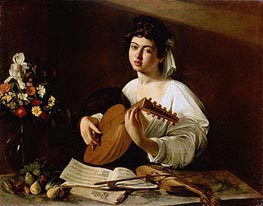
The Lute Player c.1595
Oil Painting
$3172
$3172
Canvas Print
$58.56
$58.56
SKU: CMM-2768
Michelangelo Merisi da Caravaggio
Original Size: 94 x 119 cm
The State Hermitage Museum, St. Petersburg, Russia
Michelangelo Merisi da Caravaggio
Original Size: 94 x 119 cm
The State Hermitage Museum, St. Petersburg, Russia
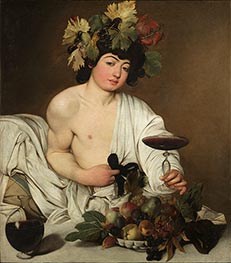
Bacchus c.1597
Oil Painting
$3717
$3717
Canvas Print
$65.79
$65.79
SKU: CMM-2769
Michelangelo Merisi da Caravaggio
Original Size: 95 x 85 cm
Galleria degli Uffizi, Florence, Italy
Michelangelo Merisi da Caravaggio
Original Size: 95 x 85 cm
Galleria degli Uffizi, Florence, Italy
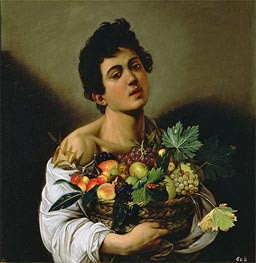
Boy with a Basket of Fruit c.1593/94
Oil Painting
$2901
$2901
Canvas Print
$72.32
$72.32
SKU: CMM-2770
Michelangelo Merisi da Caravaggio
Original Size: 70 x 67 cm
Galleria Borghese, Rome, Italy
Michelangelo Merisi da Caravaggio
Original Size: 70 x 67 cm
Galleria Borghese, Rome, Italy
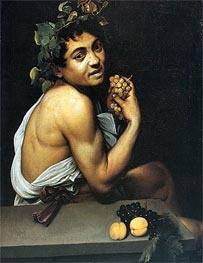
Sick Bacchus (Self-Portrait as Bacchus) c.1592/93
Oil Painting
$2231
$2231
Canvas Print
$87.94
$87.94
SKU: CMM-2771
Michelangelo Merisi da Caravaggio
Original Size: 67 x 53 cm
Galleria Borghese, Rome, Italy
Michelangelo Merisi da Caravaggio
Original Size: 67 x 53 cm
Galleria Borghese, Rome, Italy

Boy Bitten by a Lizard c.1595/00
Oil Painting
$2201
$2201
Canvas Print
$80.90
$80.90
SKU: CMM-2772
Michelangelo Merisi da Caravaggio
Original Size: 66 x 49.5 cm
National Gallery, London, United Kingdom
Michelangelo Merisi da Caravaggio
Original Size: 66 x 49.5 cm
National Gallery, London, United Kingdom
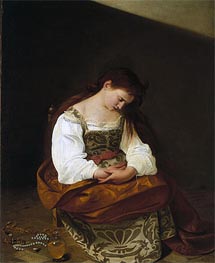
Penitent Magdalen c.1598
Oil Painting
$2337
$2337
Canvas Print
$102.15
$102.15
SKU: CMM-2773
Michelangelo Merisi da Caravaggio
Original Size: 122.5 x 98.5 cm
Galleria Doria Pamphilj, Rome, Italy
Michelangelo Merisi da Caravaggio
Original Size: 122.5 x 98.5 cm
Galleria Doria Pamphilj, Rome, Italy
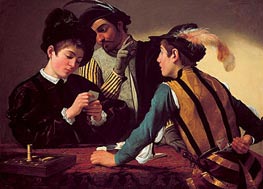
The Cardsharps (I Bari) c.1595/96
Oil Painting
$3467
$3467
Canvas Print
$53.66
$53.66
SKU: CMM-2774
Michelangelo Merisi da Caravaggio
Original Size: 90 x 112 cm
Kimbell Art Museum, Fort Worth, USA
Michelangelo Merisi da Caravaggio
Original Size: 90 x 112 cm
Kimbell Art Museum, Fort Worth, USA

The Musicians (Concert) c.1594/95
Oil Painting
$3628
$3628
Canvas Print
$57.06
$57.06
SKU: CMM-2775
Michelangelo Merisi da Caravaggio
Original Size: 92.1 x 118.4 cm
Metropolitan Museum of Art, New York, USA
Michelangelo Merisi da Caravaggio
Original Size: 92.1 x 118.4 cm
Metropolitan Museum of Art, New York, USA

The Rest on the Flight into Egypt c.1595
Oil Painting
$4257
$4257
Canvas Print
$100.56
$100.56
SKU: CMM-2776
Michelangelo Merisi da Caravaggio
Original Size: 135.5 x 166.5 cm
Galleria Doria Pamphilj, Rome, Italy
Michelangelo Merisi da Caravaggio
Original Size: 135.5 x 166.5 cm
Galleria Doria Pamphilj, Rome, Italy

Saint Francis of Assisi in Ecstasy c.1594/95
Oil Painting
$2233
$2233
Canvas Print
$89.84
$89.84
SKU: CMM-2777
Michelangelo Merisi da Caravaggio
Original Size: 93.9 x 129.5 cm
Wadsworth Atheneum, Hartford, USA
Michelangelo Merisi da Caravaggio
Original Size: 93.9 x 129.5 cm
Wadsworth Atheneum, Hartford, USA
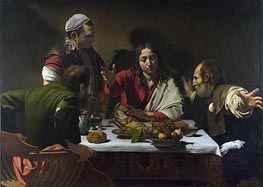
The Supper at Emmaus 1601
Oil Painting
$4410
$4410
Canvas Print
$88.61
$88.61
SKU: CMM-2778
Michelangelo Merisi da Caravaggio
Original Size: 141 x 196.2 cm
National Gallery, London, United Kingdom
Michelangelo Merisi da Caravaggio
Original Size: 141 x 196.2 cm
National Gallery, London, United Kingdom
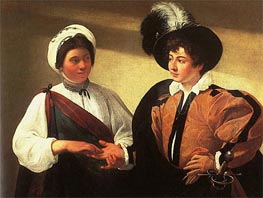
The Fortune Teller (La Zingara) c.1596/97
Oil Painting
$2922
$2922
Canvas Print
$54.48
$54.48
SKU: CMM-2779
Michelangelo Merisi da Caravaggio
Original Size: 99 x 131 cm
Louvre Museum, Paris, France
Michelangelo Merisi da Caravaggio
Original Size: 99 x 131 cm
Louvre Museum, Paris, France
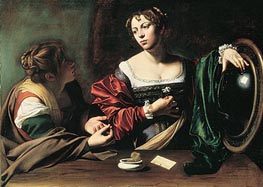
The Conversion of Mary Magdalen c.1597/98
Oil Painting
$3009
$3009
Canvas Print
$92.13
$92.13
SKU: CMM-2780
Michelangelo Merisi da Caravaggio
Original Size: 100 x 134.5 cm
Detroit Institute of Arts, Michigan, USA
Michelangelo Merisi da Caravaggio
Original Size: 100 x 134.5 cm
Detroit Institute of Arts, Michigan, USA

Saint Catherine of Alexandria c.1598/99
Oil Painting
$3172
$3172
Canvas Print
$58.02
$58.02
SKU: CMM-2781
Michelangelo Merisi da Caravaggio
Original Size: 173 x 133 cm
Thyssen-Bornemisza Museum, Madrid, Spain
Michelangelo Merisi da Caravaggio
Original Size: 173 x 133 cm
Thyssen-Bornemisza Museum, Madrid, Spain
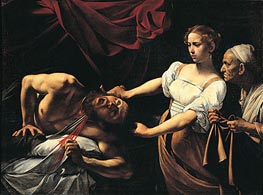
Judith Beheading Holofernes c.1599/00
Oil Painting
$4276
$4276
Canvas Print
$55.84
$55.84
SKU: CMM-2782
Michelangelo Merisi da Caravaggio
Original Size: 145 x 195 cm
Palazzo Barberini, Rome, Italy
Michelangelo Merisi da Caravaggio
Original Size: 145 x 195 cm
Palazzo Barberini, Rome, Italy
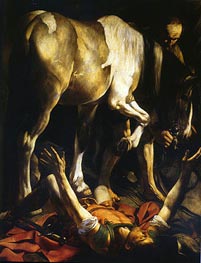
The Conversion of Saint Paul c.1600/01
Oil Painting
$3530
$3530
Canvas Print
$94.95
$94.95
SKU: CMM-2783
Michelangelo Merisi da Caravaggio
Original Size: 230 x 175 cm
Santa Maria del Popolo, Rome, Italy
Michelangelo Merisi da Caravaggio
Original Size: 230 x 175 cm
Santa Maria del Popolo, Rome, Italy

The Crucifixion of Saint Peter c.1600/01
Oil Painting
$5326
$5326
Canvas Print
$57.34
$57.34
SKU: CMM-2784
Michelangelo Merisi da Caravaggio
Original Size: 230 x 175 cm
Santa Maria del Popolo, Rome, Italy
Michelangelo Merisi da Caravaggio
Original Size: 230 x 175 cm
Santa Maria del Popolo, Rome, Italy

Basket of Fruit c.1597/00
Oil Painting
$1788
$1788
Canvas Print
$59.38
$59.38
SKU: CMM-2785
Michelangelo Merisi da Caravaggio
Original Size: 54.5 x 67.5 cm
Pinacoteca Ambrosiana, Milan, Italy
Michelangelo Merisi da Caravaggio
Original Size: 54.5 x 67.5 cm
Pinacoteca Ambrosiana, Milan, Italy
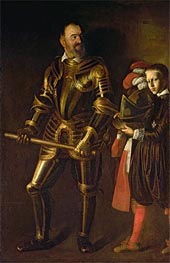
Portrait of Alof de Wignacourt, Grand Master of ... 1607
Oil Painting
$3139
$3139
Canvas Print
$49.43
$49.43
SKU: CMM-2786
Michelangelo Merisi da Caravaggio
Original Size: 194 x 134 cm
Louvre Museum, Paris, France
Michelangelo Merisi da Caravaggio
Original Size: 194 x 134 cm
Louvre Museum, Paris, France

Amor Victorious (Cupid) c.1601/02
Oil Painting
$3799
$3799
Canvas Print
$54.21
$54.21
SKU: CMM-2787
Michelangelo Merisi da Caravaggio
Original Size: 156.5 x 113.3 cm
Gemaldegalerie, Berlin, Germany
Michelangelo Merisi da Caravaggio
Original Size: 156.5 x 113.3 cm
Gemaldegalerie, Berlin, Germany

Saint Matthew and the Angel 1602
Oil Painting
$2879
$2879
Canvas Print
$49.43
$49.43
SKU: CMM-2788
Michelangelo Merisi da Caravaggio
Original Size: 295 x 195 cm
San Luigi dei Francesi, Rome, Italy
Michelangelo Merisi da Caravaggio
Original Size: 295 x 195 cm
San Luigi dei Francesi, Rome, Italy
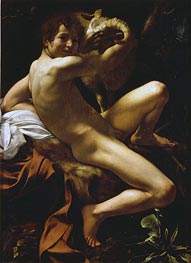
Saint John the Baptist 1602
Oil Painting
$3233
$3233
Canvas Print
$90.72
$90.72
SKU: CMM-2789
Michelangelo Merisi da Caravaggio
Original Size: 129 x 95 cm
Musei Capitolini, Rome, Italy
Michelangelo Merisi da Caravaggio
Original Size: 129 x 95 cm
Musei Capitolini, Rome, Italy

The Betrayal of Christ (Taking of Christ) 1602
Oil Painting
$4471
$4471
Canvas Print
$58.70
$58.70
SKU: CMM-2790
Michelangelo Merisi da Caravaggio
Original Size: 135.5 x 169.5 cm
National Gallery, Dublin, Ireland
Michelangelo Merisi da Caravaggio
Original Size: 135.5 x 169.5 cm
National Gallery, Dublin, Ireland
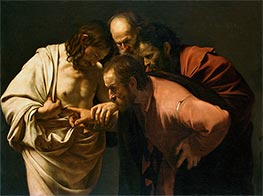
The Incredulity of Saint Thomas (Doubting Thomas) c.1601
Oil Painting
$3479
$3479
Canvas Print
$55.70
$55.70
SKU: CMM-2791
Michelangelo Merisi da Caravaggio
Original Size: 108.5 x 145 cm
Schloss Sanssouci, Potsdam, Germany
Michelangelo Merisi da Caravaggio
Original Size: 108.5 x 145 cm
Schloss Sanssouci, Potsdam, Germany